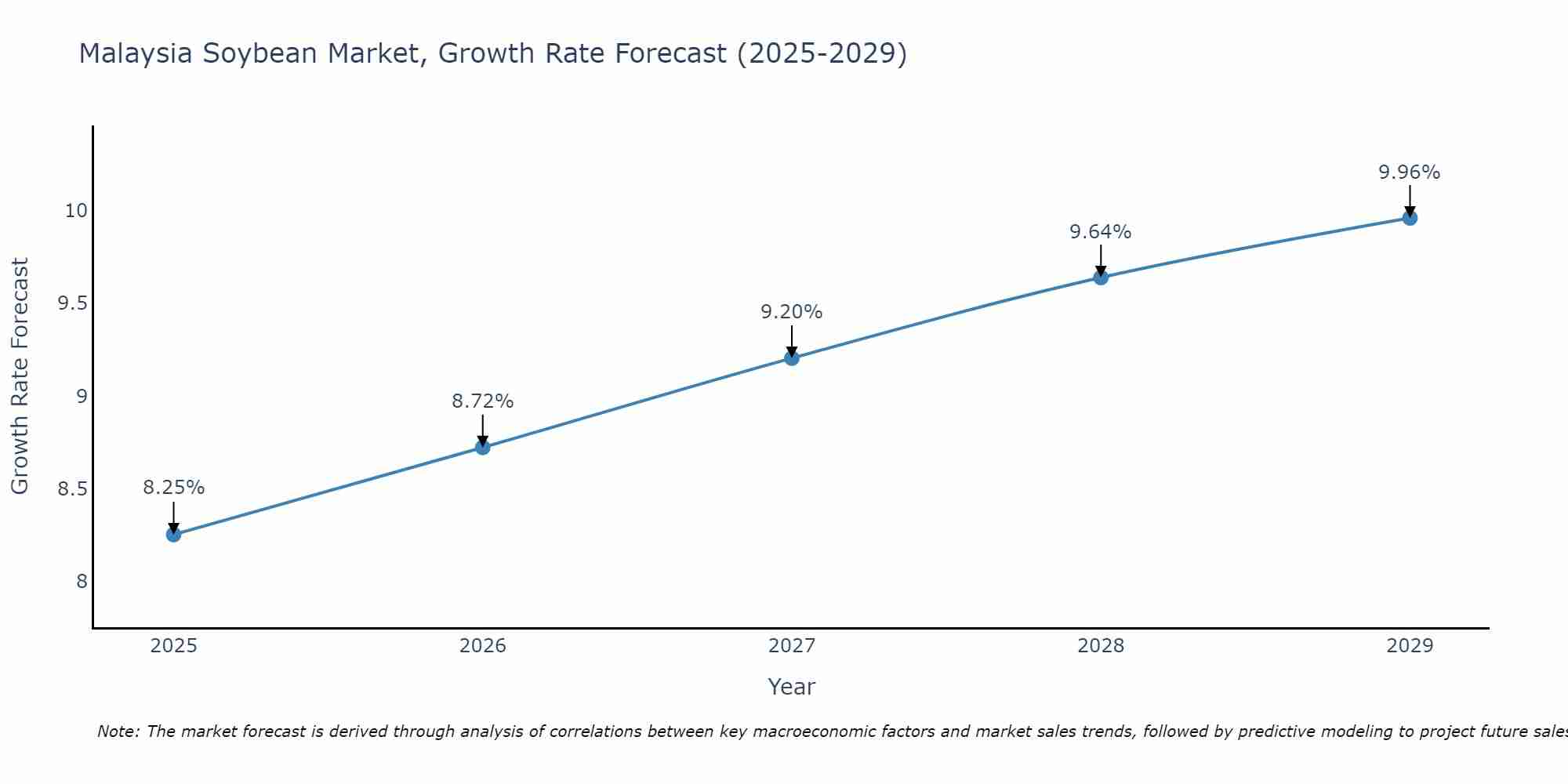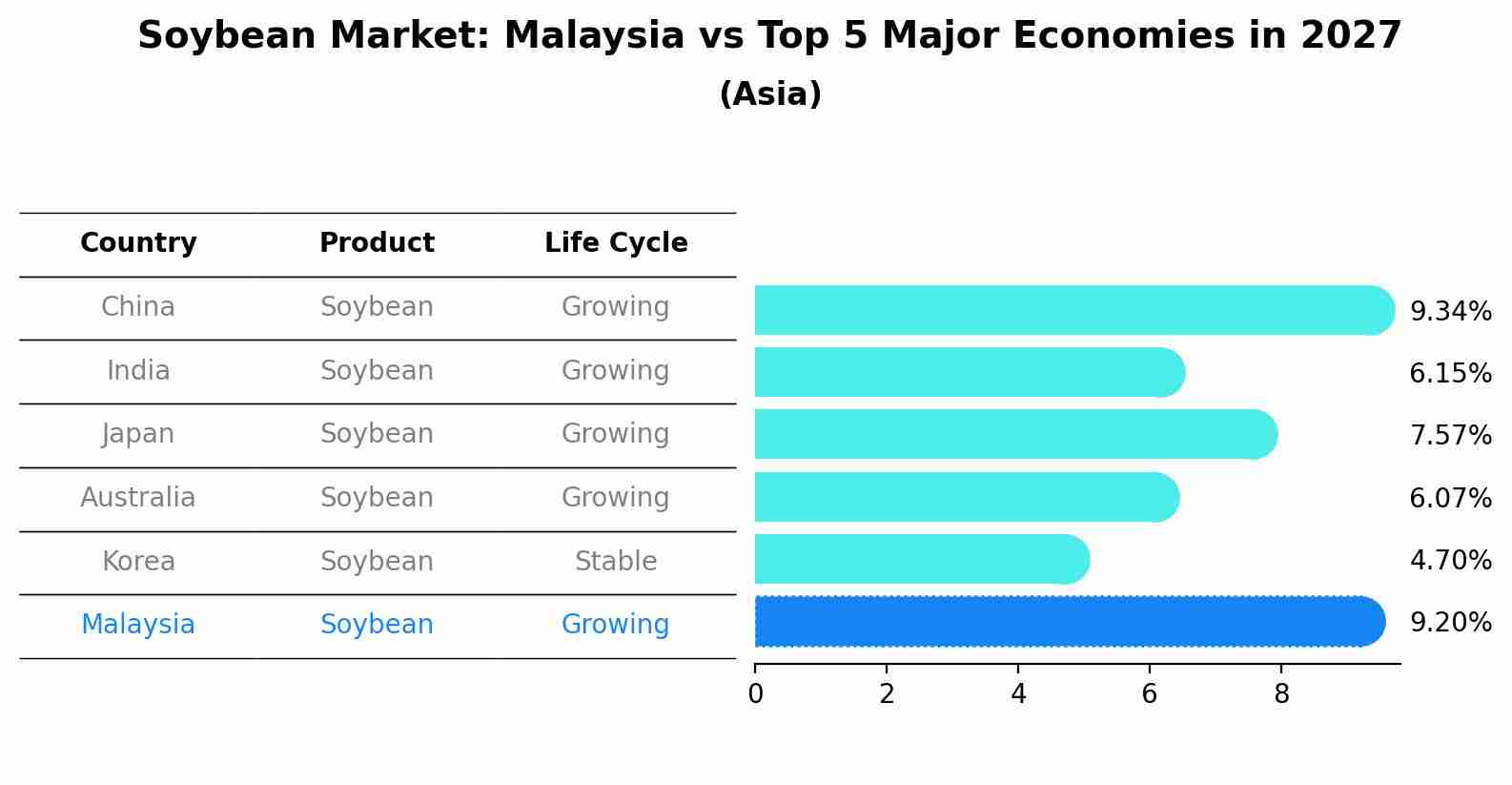Malaysia Soybean Market (2025-2031) Outlook | Companies, Share, Trends, Value, Industry, Size, Forecast, Growth, Revenue & Analysis
| Product Code: ETC224666 | Publication Date: Aug 2022 | Updated Date: Aug 2025 | Product Type: Market Research Report | |
| Publisher: 6Wresearch | Author: Ravi Bhandari | No. of Pages: 75 | No. of Figures: 35 | No. of Tables: 20 |
Malaysia Soybean Market Size Growth Rate
The Malaysia Soybean Market is likely to experience consistent growth rate gains over the period 2025 to 2029. From 8.25% in 2025, the growth rate steadily ascends to 9.96% in 2029.

Soybean Market: Malaysia vs Top 5 Major Economies in 2027 (Asia)
By 2027, the Soybean market in Malaysia is anticipated to reach a growth rate of 9.20%, as part of an increasingly competitive Asia region, where China remains at the forefront, supported by India, Japan, Australia and South Korea, driving innovations and market adoption across sectors.

Malaysia Soybean Market Synopsis
The soybean market in Malaysia is experiencing steady growth, primarily driven by the demand for soybean products in the food and beverage industry. Soybeans are a valuable source of protein and are used in a wide range of products, including tofu, soy milk, and soy-based meat alternatives. With the rising interest in plant-based diets and protein-rich foods, the demand for soybeans is expected to continue its upward trend. Additionally, soybean cultivation may provide economic opportunities for local farmers.
Drivers of the Market
The Malaysia soybean market is expected to see steady growth in the foreseeable future. The primary driver behind this growth is the increasing demand for soybean-based products, particularly in the food and beverage industry. Soybeans are a key ingredient in the production of tofu, soy milk, and various soy-based meat alternatives, all of which are gaining popularity among health-conscious consumers and those following plant-based diets. Additionally, the feed industry also contributes to the demand for soybeans as livestock and poultry feed, further boosting the market.
Challenges of the Market
The Malaysia soybean market faces competition from palm oil and other oilseeds. Consumer perception of soybean products can be influenced by concerns over genetically modified organisms (GMOs). Ensuring a stable supply of non-GMO soybeans and addressing sustainability issues in soybean cultivation are critical challenges.
COVID 19 Impact on the Market
In the case of the Malaysia soybean market, the COVID-19 pandemic had a significant impact, primarily due to supply chain disruptions and labor shortages. These challenges affected the availability and pricing of soybeans in the market. However, as the situation improved, the market recovered. Soybeans are a crucial ingredient in various food products, including tofu, soy milk, and meat substitutes. The growing trend towards plant-based diets and increased awareness of the health benefits of soy products fueled demand. Manufacturers also embraced sustainability practices in soybean cultivation and processing to meet consumers` ethical and environmental concerns. The outlook for the soybean market in Malaysia is positive, driven by health-conscious consumers and the continued expansion of plant-based food options.
Key Players in the Market
Major players in the Malaysia soybean market include Louis Dreyfus Company, Bunge Limited, and IOI Corporation Berhad. These companies are involved in soybean processing, distribution, and trade, contributing to the supply of soybean products for various industrial and culinary purposes.
Key Highlights of the Report:
- Malaysia Soybean Market Outlook
- Market Size of Malaysia Soybean Market, 2024
- Forecast of Malaysia Soybean Market, 2031
- Historical Data and Forecast of Malaysia Soybean Revenues & Volume for the Period 2021-2031
- Malaysia Soybean Market Trend Evolution
- Malaysia Soybean Market Drivers and Challenges
- Malaysia Soybean Price Trends
- Malaysia Soybean Porter's Five Forces
- Malaysia Soybean Industry Life Cycle
- Historical Data and Forecast of Malaysia Soybean Market Revenues & Volume By Applications for the Period 2021-2031
- Historical Data and Forecast of Malaysia Soybean Market Revenues & Volume By Crush for the Period 2021-2031
- Historical Data and Forecast of Malaysia Soybean Market Revenues & Volume By Feed Use for the Period 2021-2031
- Historical Data and Forecast of Malaysia Soybean Market Revenues & Volume By Food Use for the Period 2021-2031
- Malaysia Soybean Import Export Trade Statistics
- Market Opportunity Assessment By Applications
- Malaysia Soybean Top Companies Market Share
- Malaysia Soybean Competitive Benchmarking By Technical and Operational Parameters
- Malaysia Soybean Company Profiles
- Malaysia Soybean Key Strategic Recommendations
Frequently Asked Questions About the Market Study (FAQs):
1 Executive Summary |
2 Introduction |
2.1 Key Highlights of the Report |
2.2 Report Description |
2.3 Market Scope & Segmentation |
2.4 Research Methodology |
2.5 Assumptions |
3 Malaysia Soybean Market Overview |
3.1 Malaysia Country Macro Economic Indicators |
3.2 Malaysia Soybean Market Revenues & Volume, 2021 & 2031F |
3.3 Malaysia Soybean Market - Industry Life Cycle |
3.4 Malaysia Soybean Market - Porter's Five Forces |
3.5 Malaysia Soybean Market Revenues & Volume Share, By Applications, 2021 & 2031F |
4 Malaysia Soybean Market Dynamics |
4.1 Impact Analysis |
4.2 Market Drivers |
4.2.1 Increasing health consciousness and demand for plant-based protein sources |
4.2.2 Growing awareness about the nutritional benefits of soybeans |
4.2.3 Government initiatives to promote soybean cultivation and consumption |
4.3 Market Restraints |
4.3.1 Fluctuating prices of soybeans in the international market |
4.3.2 Competition from other protein sources such as meat and dairy products |
4.3.3 Environmental concerns related to soybean cultivation practices |
5 Malaysia Soybean Market Trends |
6 Malaysia Soybean Market, By Types |
6.1 Malaysia Soybean Market, By Applications |
6.1.1 Overview and Analysis |
6.1.2 Malaysia Soybean Market Revenues & Volume, By Applications, 2021-2031F |
6.1.3 Malaysia Soybean Market Revenues & Volume, By Crush, 2021-2031F |
6.1.4 Malaysia Soybean Market Revenues & Volume, By Feed Use, 2021-2031F |
6.1.5 Malaysia Soybean Market Revenues & Volume, By Food Use, 2021-2031F |
7 Malaysia Soybean Market Import-Export Trade Statistics |
7.1 Malaysia Soybean Market Export to Major Countries |
7.2 Malaysia Soybean Market Imports from Major Countries |
8 Malaysia Soybean Market Key Performance Indicators |
8.1 Average yield per hectare of soybean cultivation in Malaysia |
8.2 Percentage increase in soybean consumption over the past year |
8.3 Number of new product launches incorporating soybeans in Malaysia |
8.4 Adoption rate of soybean-based products in the Malaysian market |
8.5 Percentage of agricultural land allocated to soybean cultivation in Malaysia |
9 Malaysia Soybean Market - Opportunity Assessment |
9.1 Malaysia Soybean Market Opportunity Assessment, By Applications, 2021 & 2031F |
10 Malaysia Soybean Market - Competitive Landscape |
10.1 Malaysia Soybean Market Revenue Share, By Companies, 2024 |
10.2 Malaysia Soybean Market Competitive Benchmarking, By Operating and Technical Parameters |
11 Company Profiles |
12 Recommendations |
13 Disclaimer |
- Single User License$ 1,995
- Department License$ 2,400
- Site License$ 3,120
- Global License$ 3,795
Search
Thought Leadership and Analyst Meet
Our Clients
Related Reports
- Afghanistan Apparel Market (2026-2032) | Growth, Outlook, Industry, Segmentation, Forecast, Size, Companies, Trends, Value, Share, Analysis & Revenue
- Canada Oil and Gas Market (2026-2032) | Share, Segmentation, Value, Industry, Trends, Forecast, Analysis, Size & Revenue, Growth, Competitive Landscape, Outlook, Companies
- Germany Breakfast Food Market (2026-2032) | Industry, Share, Growth, Size, Companies, Value, Analysis, Revenue, Trends, Forecast & Outlook
- Australia Briquette Market (2025-2031) | Growth, Size, Revenue, Forecast, Analysis, Trends, Value, Share, Industry & Companies
- Vietnam System Integrator Market (2025-2031) | Size, Companies, Analysis, Industry, Value, Forecast, Growth, Trends, Revenue & Share
- ASEAN and Thailand Brain Health Supplements Market (2025-2031) | Strategy, Consumer Insights, Analysis, Investment Trends, Opportunities, Growth, Size, Share, Industry, Revenue, Segments, Value, Segmentation, Supply, Forecast, Restraints, Outlook, Competition, Drivers, Trends, Demand, Pricing Analysis, Competitive, Strategic Insights, Companies, Challenges
- ASEAN Bearings Market (2025-2031) | Strategy, Consumer Insights, Analysis, Investment Trends, Opportunities, Growth, Size, Share, Industry, Revenue, Segments, Value, Segmentation, Supply, Forecast, Restraints, Outlook, Competition, Drivers, Trends, Demand, Pricing Analysis, Competitive, Strategic Insights, Companies, Challenges
- Europe Flooring Market (2025-2031) | Outlook, Share, Industry, Trends, Forecast, Companies, Revenue, Size, Analysis, Growth & Value
- Saudi Arabia Manlift Market (2025-2031) | Outlook, Size, Growth, Trends, Companies, Industry, Revenue, Value, Share, Forecast & Analysis
- Uganda Excavator, Crane, and Wheel Loaders Market (2025-2031) | Strategy, Consumer Insights, Analysis, Investment Trends, Opportunities, Growth, Size, Share, Industry, Revenue, Segments, Value, Segmentation, Supply, Forecast, Restraints, Outlook, Competition, Drivers, Trends, Demand, Pricing Analysis, Competitive, Strategic Insights, Companies, Challenges
Industry Events and Analyst Meet
Whitepaper
- Middle East & Africa Commercial Security Market Click here to view more.
- Middle East & Africa Fire Safety Systems & Equipment Market Click here to view more.
- GCC Drone Market Click here to view more.
- Middle East Lighting Fixture Market Click here to view more.
- GCC Physical & Perimeter Security Market Click here to view more.
6WResearch In News
- Doha a strategic location for EV manufacturing hub: IPA Qatar
- Demand for luxury TVs surging in the GCC, says Samsung
- Empowering Growth: The Thriving Journey of Bangladesh’s Cable Industry
- Demand for luxury TVs surging in the GCC, says Samsung
- Video call with a traditional healer? Once unthinkable, it’s now common in South Africa
- Intelligent Buildings To Smooth GCC’s Path To Net Zero


















